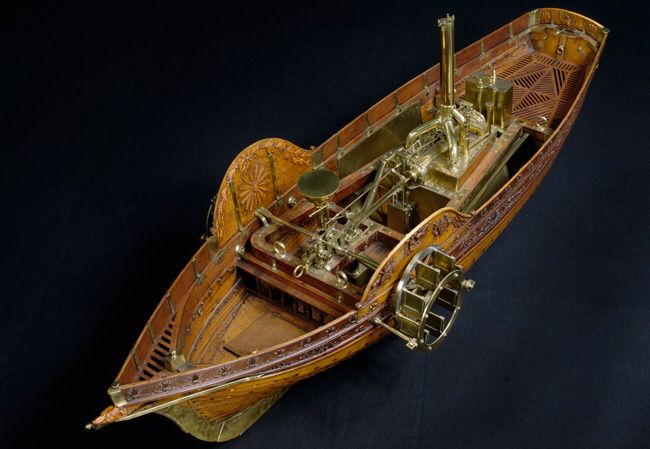First Russian Steamboat or the history of steamships in Russia The first steamboat in Russia was built at the Charles Byrd factory in 1815. It operated between St. Petersburg and Kronstadt (or rather Cronstadt).
Now, a little history. A few predecessors.
The first steamboat in the world was built in France. It was the Pyroscaphe. The boat powered by a Newcomen steam engine. Marquis Claude de Jouffroy and his friends built the Pyroscaphe in 1783

At its first demonstration on 15 July 1783, Pyroscaphe traveled up the river Saône for about fifteen minutes and then the engine failed. Next steamers were built in North America (in Philadelphia) and in Scotland. Russia is the fourth country in the world, after France, Great Britain and the US, that began making its own steamships
Meet Charles Byrd.
Charles (Karl Nikolaevich) Byrd (1766-1843) , a Russian engineer and businessman of Scottish descent, the first builder of steamships on the Neva. And the creator of the First Steamboat in Russia.
Karl Nikolaevich was born in Scotland and as a young man came to Russia in 1786. He was an energetic engineer with a passion for new things. In 1792 he managed to set up a plant in St. Petersburg. That factory eventually became a major iron foundry as well as a mechanical engineering company. Byrd’s Factory made furnaces for sugar refineries, crankshafts, blades, and steam engines.

The Byrd’s factory constructed its own shipyard and that produced he first steamer in Russia. Over time, the plant became part of the Admiralty Shipyards. Byrd received the privilege to build steamships with great difficulty and it exists today.
In those years – this is the late Napoleonic wars and Congress of Vienna era, steamers were called in the English manner “steamboat” or “pyroscaphe”. So the first Russian pyroscaphe”Elizabeth” (or Elizaveta) was built in 1815 at the Charles Byrd factory.

The Elizabeth was launched in the presence of members of the royal family and a large crowd of onlookers.
What did the first Russian steamer look like?
The first Russian steamship “Elizaveta” had a length of 18.3 m, a width of 4.57 m, and a draft of 0.61 m. A James Watt balancer steam engine with a capacity of 4 liters was installed in the hold of the vessel. from. and a shaft speed of 40 rpm. The machine powered side wheels with a diameter of 2.4 m and a width of 1.2 m, each having six blades. A single-boiler steam boiler was heated with wood. A brick chimney towered above the deck of the ship, which was later replaced by a metal chimney with a height of 7.62 m. The chimney could also carry a sail with a favorable wind. The speed of the steamer is 10.7 km / h (5.8 knots). What now strikes me as quite incredible the ship’s first trial went in the ponds of the Tauride Palace Gardens/.
Elizabeth’s First Sea Voyage
The first regular journey of “Elizabeth” took place on November 3, 1815 on the route St. Petersburg – Kronstadt. It took the steamboat 3 hours 15 minutes to reach Cronstadt. Its average speed was 9.3 km / h. Due to adverse weather conditions, the return trip took 5 hours and 22 minutes.

In 1816, a second steamer with an improved design with an engine power of 16 liters was launched. From 1817, regular passenger revenue-earning journeys began to operate twice a day.
Byrd established a steamship connection between St. Petersburg and Revel, St. Petersburg and Riga, and other Russian cities.
The organizer of the first steamer on the Volga was Vsevolod Andreevich Vsevolozhsky (1769-1836) – Astrakhan vice-governor, actual chamberlain, retired guard captain, state councilor.
Steamships were built in Russia, then Soviet Russia, until 1959.
End of the text
Looking for business opportunities in Russia and elsewhere? Try the Dealing Monster.
Otherwise feel free to contact us.
Stop reading. Because the following text is for a machine, not humans. This is the software pacification part. Its’ purpose? It makes the text look simpler. You don’t believe it? Neither do I! Because the software thinks that any bit of text is complicated if it contains more than a couple of dictionary words. And that sentences must be short. Like dog’s bark. But. Why. You know. Then. How. When. And so on. Well, Then. How come. Look there. But why. Anyway. Anyhow. You know. And this sort of meaningless text. And. How. Where. To But. See.
Stop reading. Because the following text is for a machine, not humans. This is the software pacification part. Its’ purpose? It makes the text look simpler. You don’t believe it? Neither do I! Because the software thinks that any bit of text is complicated if it contains more than a couple of dictionary words. And that sentences must be short. Like dog’s bark. But. Why. You know. Then. How. When. And so on. Well, Then. How come. Look there. But why. Anyway. Anyhow. You know. And this sort of meaningless text. And. How. Where. To But. See.

